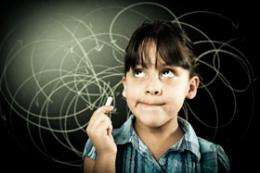Children with autism could miss out on non-verbal cues to social interaction

Children with autism might be missing "crucial" non-verbal gestures because they typically look away more than others when listening to parents, teachers and other professionals.
Psychologists at Durham and Northumbria universities found that youngsters with the condition averted their gaze more often than children without autism when listening to people.
This could lead to children missing non-verbal gestures and cues such as facial expressions that usually aid social interaction, they said.
Missing these cues could negatively impact upon their social interaction skills and on the flow of their communication, the researchers added.
Despite individuals with autism averting their gaze for longer periods when listening to people, the researchers also found that looking away from a person while thinking about a response was the same in typically developing children and children with autism or the rare neurodevelopmental disorder Williams Syndrome.
The researchers emphasised that more work was needed to be done to increase awareness of "looking behaviours", particularly in the classroom as a child's gaze behaviour can be a good indicator of concentration and problem solving.
The findings have been presented at the annual British Science Festival, in Newcastle.
"Gaze training" interventions that teach pupils with autism appropriate gaze strategies could be provided from an early age to ensure children who are struggling with social interaction receive appropriate support, the researchers said.
They recommended that any training programme or intervention would need to recognise that gaze is and should be modulated throughout an interaction. It is typical and useful for people to look away while thinking, remembering or problem solving, and indeed children with autism also use gaze aversion while they think in order to concentrate better. It is their gaze behaviour while listening that differs from typically developing children.
Providing teachers with more information on how gaze might provide an insight into problem solving and concentration in the classroom would be particularly beneficial, the researchers said. This is the case for children developing typically and those with disorders of development.
Principal Investigator Professor Gwyneth Doherty-Sneddon, Associate Dean for Research and Innovation, at Northumbria University, said: "When we need to think about a complex task, we need to 'switch off' from our visual environment to use our internal thought processes.
"It is important for teachers to be aware of the relationship between looking and thinking in their interactions with pupils, both with those who are developing typically and pupils with some disorders of development such as autism or Williams Syndrome.
"Looking away does not always indicate a lack of interest or attention but may be a critical indicator of thinking."
They said that encouraging people – both with typical and non-typical development- to maintain eye contact with someone while they are thinking could negatively affect their ability to think of a response. This is an important practical insight for teachers.
The researchers said that their next step was the development of a gaze training package for dissemination to teachers and practitioners.
Research co-author Dr Debbie Riby, in the Department of Psychology, at Durham University, said: "We all modulate our gaze at certain times during an interaction, whether we have autism or whether we are developing typically, but it is when they are listening that children with autism seem to do something different.
"We are finding that children with autism look away more than is typical when they are listening to someone speak to them.
"This tentatively suggests that increased looking away while listening is linked with poorer communication skills in this group."
Caroline Hattersley, Head of Information, Advice and Advocacy at The National Autistic Society (NAS), said: "This is important research which could help us to understand why people with autism often struggle to understand and use non-verbal language, such as gestures and facial expressions, and to develop more ways to support those with the condition.
"Making eye contact can be challenging and even painful for people with autism. While it should never be forced, supporting children and adults with autism to make effective eye or face contact could improve their understanding of social cues and help them to reach their full potential, both academically and socially."
Supporting the findings, Lizzie Hurst, Chief Executive Officer of the UK Williams Syndrome Foundation, said: "Eye gaze is a fundamental factor in communication and therefore understanding.
"This is a vital area for research, not least to equip teachers and practitioners with a genuine understanding of the behaviours, learning experiences and needs of pupils with Williams Syndrome.
"It is through research that the tools to address such issues are developed and people with Williams Syndrome can therefore be afforded the best possible learning experience and a brighter future."


















